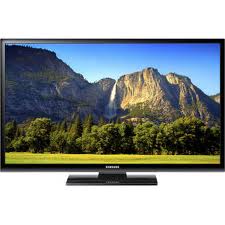Samsung PN43E450: Full Review – Part 4
Thursday, September 20th, 2012 2:41:34 by Usman Khalid
In light of excellent performance elsewhere it’s disppointing to see this TV fall down in terms of picture processing. But what does this mean in the real world? If you watch a lot of Blu-ray movies the TVs inability to provide 1080p/24 cadence means that film buffs might notice judder, especially on pans, but on most material, there won’t be much of an effect. Meanwhile, failing the 1080i deinterlacing test means that details featuring parallel lines (grilles, buildings, etc.) may become lost in moire effects or jaggies. Neither issue is liable to trip up casual viewers.
The E450 has a glossy, grayish screen finish similar to that of the E550 and the Panasonics, which washes out quite a bit in a well-lit room. Blacks on the E450 look brown when viewed in a lit room, and if you have the misfortune to sit underneath a window, then you’ll see that reflected quite clearly in the Samsung. The otherwise-inferior LG PA6500 is actually a better performer in the light, but if you’re looking for an extraordinary lit-room performance in a plasma, you’re unfortunately going to have to pay a lot more and get a TV like the ST50 or Samsung’s PNE6500.
Plasmas traditionally can be relied upon to do two things: 1) use a lot of electricity and 2) heat up your living area. One of the most surprising things about the Samsung E450’s performance was how little power the TV actually used.
While the more expensive, 1080p resolution E550 uses about 220W in calibrated mode — standard for a plasma TV — the E450 uses a bit more than that at about 120W, and all without sacrificing brightness. At such small power output, the TV puts out no more heat than a standard light bulb. It’s still not nearly as effecient as an LED TV, but it’s better than any of the 50-inch 1080p plasmas we’ve tested.
Tags: flat screen, home theatre, LCD, LED, plasma, Samsung PN43E450, Smart TVShort URL: https://www.newspakistan.pk/?p=32974

















